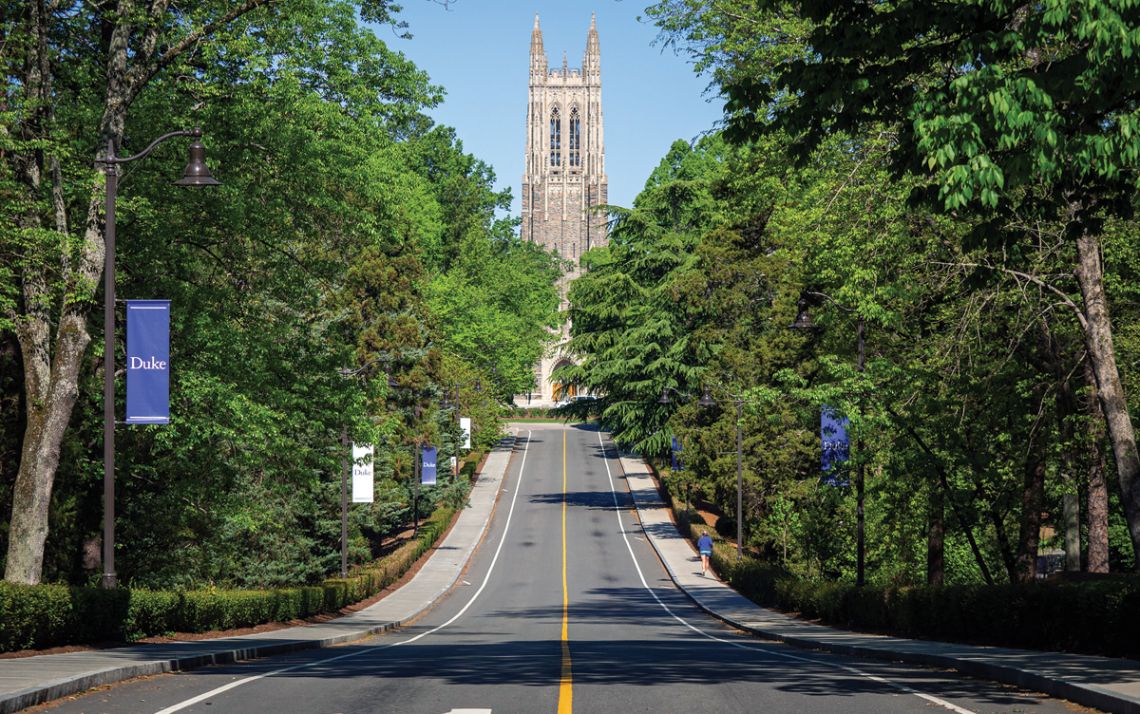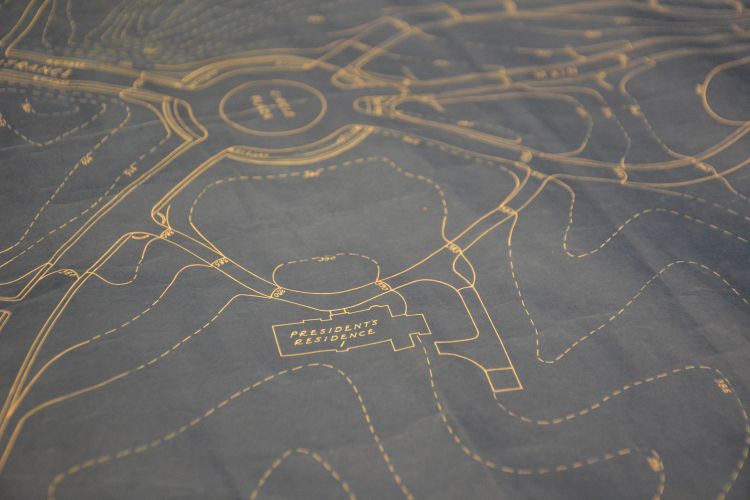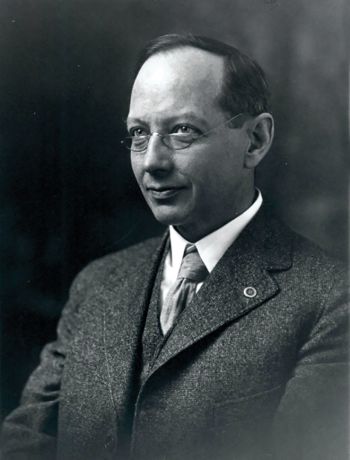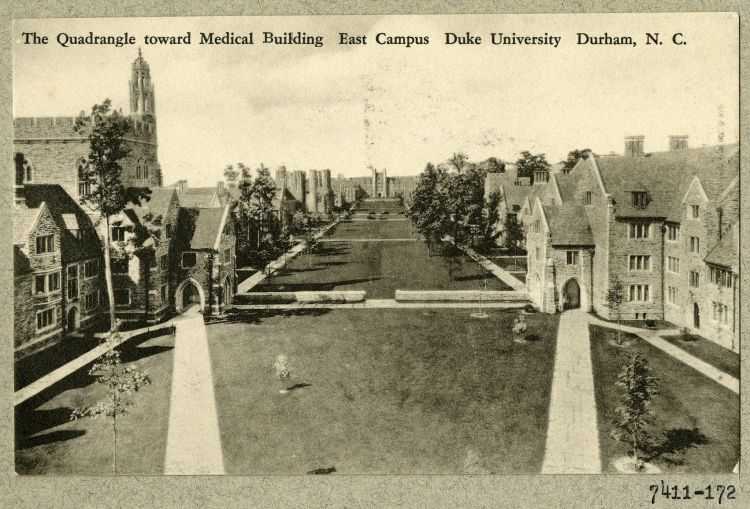Legacy in a Landscape
Work of iconic landscape architecture firm remains in historic campus design

Few people can appreciate the drive up to Duke University Chapel like Ron Jones.
For 23 years, the bus driver at Duke has piloted the C1 East-West bus, carrying passengers from East Campus to the heart of West Campus around 18 times per shift.
Each time, the bus glides down the slight slope of Chapel Drive as glimpses of Sarah P. Duke Gardens appear through trees. Then, the roadway begins an ascent, rising around 30 feet toward campus until the tree-lined corridor gives way to green lawns, sprawling oaks and stone buildings of Abele Quad.
"Every time I make that turn, and drive toward the Chapel, it's breathtaking," Jones said. "It's beautiful, even if you see it every day."
Nearly a century after the dramatic approach to West Campus was sketched out by architects from the Olmsted Brothers' landscape architecture firm, it still creates awe.
"There's so much elegance to it," Duke University Landscape Architect Mark Hough said of the gentle fall-and-rise of the Chapel Drive approach. "It's just enough to give you that sense of arrival. That, to me, is the kind of nuanced design that you sort of take for granted."
When the story of the design of Duke's campus is told, the Horace Trumbauer architectural firm, which designed Duke's iconic buildings, is often at the forefront. But quietly, the genius of the Olmsted Brothers' landscape architecture shines through in peaceful green spaces, graceful roadways and the balance between symmetrical order and rolling woodland.
The Olmsted influence gives Duke a shared lineage with some of the country's most beloved spaces, such as New York's Central Park and the U.S. Capitol grounds, and showcases how a mix of ambition, artistry and resourcefulness created a campus that, even after decades of growth, remains majestic.

The Story Behind the Design
Hough came to Duke in 2000 with a keen understanding of what having an Olmsted Brothers' landscape meant. He'd previously worked at the Central Park Conservancy, a non-profit that maintains Central Park, the iconic 843-acre greenspace in the heart of Manhattan. It's the defining work of Frederick Law Olmsted, who, through his work in the 19th century, became recognized as the father of modern landscape architecture.
 Frederick Law Olmsted, who died in 1903, and the Olmsted Brothers firm started in 1898 by his sons, John Charles and Frederick Law Olmsted Jr., designed spaces that honored their clients' visions but stayed true to the natural character of the land by using the interplay of light and shade, and thoughtful layers of plants, to enhance its features. Their landscapes were also meant to nourish the spirits of the people who experienced them through accessible green spaces and an emphasis on harmony over eye-grabbing dramatic elements.
Frederick Law Olmsted, who died in 1903, and the Olmsted Brothers firm started in 1898 by his sons, John Charles and Frederick Law Olmsted Jr., designed spaces that honored their clients' visions but stayed true to the natural character of the land by using the interplay of light and shade, and thoughtful layers of plants, to enhance its features. Their landscapes were also meant to nourish the spirits of the people who experienced them through accessible green spaces and an emphasis on harmony over eye-grabbing dramatic elements.
Through Olmsted himself, and the Olmsted Brothers firm, the Olmsted name is on the landscape architecture of many of the country's most beloved spaces, including Asheville's Biltmore Estate, and elements of national parks such as Acadia, the Great Smoky Mountains and Yosemite.
"There's an overarching desire to be stewards of the land," said Hough, who has written extensively about the Olmsteds and delivered remarks last year at a conference celebrating the 200th anniversary of Frederick Law Olmsted's birth. "They tried to accommodate the design to fit the topography and have a gentle imprint on the land and maximize its natural qualities."
In the early 2000s, Hough studied Duke's original plans at the Frederick Law Olmsted National Historic Site in Massachusetts, where the National Park Service keeps the papers of the Olmsted Brothers firm, which closed in 1980. There, he saw drawings and correspondence that showed how the landscape architecture of West Campus was a departure from what was originally envisioned by the Olmsted Brothers.
Early versions of the campus plan, drawn in early 1925, featured clusters of Trumbauer-designed buildings extending out at two different angles from a central chapel. Also, early on there were plans for a large lake where Sarah P. Duke Gardens is now, a round fountain at the traffic circle where Campus Drive and Chapel Drive meet, and a landscape filled with rolling streams and quiet grottos.
But after James B. Duke died in the fall of 1925, funding for the construction of West Campus became tighter and many parts of the plan were reined in.
Trumbauer's firm turned the clusters of buildings into the smaller, orderly quads seen on West Campus today. And the Olmsted firm left the water features behind, instead letting the rolling woodland, laced with graceful curving roads, provide a lush, tree-filled backdrop for Trumbauer's buildings, which the Olmsted architects sited atop a dramatic ridgeline.
"The buildings were more set into the landscape instead of the landscape being manipulated," Hough said.

A Lasting Imprint
The Olmsted Brothers worked with Duke until the 1960s, offering general plans to guide the growth of campus. Hough said that as campus grows, he tries to stay true to the spirit of the Olmsted firm's vision, incorporating trees as much as possible and taking inspiration from a lake that once appeared in early plans of West Campus when designing the Duke Pond that sits on the northwest corner of campus.
The legacy of the Olmsted Brothers firm lives on in some of Duke's most prominent and beloved spaces, from Chapel Woods to the oak-shaded lawns of East Campus, and the tree-lined Campus Drive, which meanders for a little more than a mile between the East and West campuses.
Senior Associate Director Stacy Rusak has spent several years working in Undergraduate Admissions' offices in the sprawling Campus Drive house originally built for the university president in 1931. Each time she takes a walk, or enjoys the view from her office window, Rusak appreciates the forested corridor of Campus Drive and the rolling hills that surround West Campus, all pieces of the Olmsted Brothers' enduring vision.
"You see squirrels, birds and butterflies, and trees that change with the seasons," Rusak said. "You feel like you work in a forest. It feels different than most campuses."
Send story ideas, shout-outs and photographs through our story idea form or write working@duke.edu.